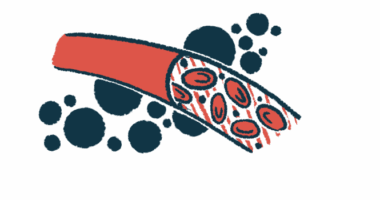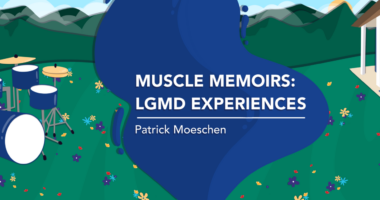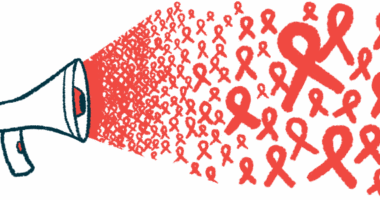In their own words: Personal journeys through DMD treatment
Last updated Aug. 8, 2024, by Mary Chapman
Duchenne muscular dystrophy (DMD) can affect all aspects of everyday life. Over time, muscle weakness and wasting become more pronounced. Walking ultimately becomes more difficult, and those with the disease, which mostly affects boys, may have heart and breathing problems, among other symptoms.
Scientific advances have helped those with DMD live longer and richer lives. A number of treatments can help with symptoms and even slow disease progression including gene therapy and exon-skipping therapies.
But not every DMD treatment is pharmaceutical. Treatment can encompass physical therapy (PT), counseling, assistive devices, home adaptations, taking part in clinical trials, and even caregiving.
Here is how four people with Duchenne manage the disease and its symptoms while living their lives.
Sumukha Terakanambi, 25
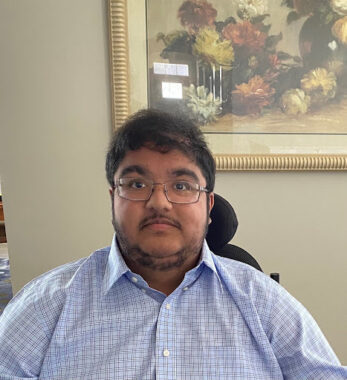
Sumukha Terakanambi at home in May 2021. (Courtesy of the Muscular Dystrophy Association)
When Sumukha Terakanambi was 2, his parents noticed he got tired after walking short distances and struggled to complete basic physical tasks. Preschool teachers noted his lagging motor skills. Two years later, his family learned he had Duchenne, the most common form of muscular dystrophy (MD).
Terakanambi and his family got involved with the Muscular Dystrophy Association (MDA), and as a child, he attended its MDA Summer Camp, where he had fun and bonded with others who had MD. He also took part, along with family and friends, in the MDA Muscle Walk, an annual fundraising event.
Terakanambi, 25, lives with his parents, who are his primary caregivers, and his 22-year-old brother in Lakeville, Minnesota. Specialized equipment and adaptations to their home are part of his everyday life.
He uses a power wheelchair and has a home ceiling lift to help him with transfers, such as from his wheelchair to his bed. He also has a shower chair, a specialized bed with a mechanical turning system, and a bilevel positive airway pressure machine to help him breathe at night.
“I also have a couple of ramps to help me get in and out of the house, and we have a home elevator so that I can get to the basement,” Terakanambi says.
Managing his medications and supportive treatments, including PT, are all part of his DMD journey. Terakanambi recently switched to a new corticosteroid with fewer side effects and takes herbal supplements to help counteract any that he does experience. He also takes an angiotensin receptor blocker for his heart.
Though Terakanambi goes out on his own in the Lakeville area, including for DMD advocacy efforts, he sometimes needs help with tasks. During those times, he uses a service that provides a “direct support professional” who is similar to a personal care assistant (PCA)
“We were having issues finding PCAs, so this was a good alternative,” he says.
Terakanambi graduated in May from the University of Minnesota with a master’s degree in public policy. While he was in graduate school, the support service hired some of his friends to assist him.
“They helped me with things such as setting up my materials for class, handing me my disposable urinal so I could use the restroom, helping me wash my hands, and helping me get my lunch in the cafeteria,” he says.
Terakanambi is now a policy consultant for the Minnesota Council on Disability and the Minnesota Rare Disease Advisory Council. He is also a graduate of Partners in Policymaking, an advocacy and leadership training program aimed at giving those with disabilities and their families the skills and resources to effectively communicate with elected officials. For him, potential advocacy issues abound, often involving inaccessible buildings.
“When I was in college as an undergrad, there were a lot of issues regarding access that I’d bring the school’s attention to for necessary renovations,” Terakanambi says. “Even now, if we go out to eat, my parents will have to help with access. Then we bring it to the attention of whomever can address it.”
Terakanambi plans to use his education and experience to heighten awareness about living with a neuromuscular disease such as DMD.
Rayyan Asif, 9
Samin Khan was completely surprised by her son Rayyan Asif’s 2018 diagnosis. Rayyan, 9, has three older siblings and there was no family history of DMD.
“I still question myself about what went wrong, where,” says Khan, who is married to Kamran Asif, a construction site supervisor, and lives in Queens, New York. “I asked the doctor, and she said, ‘Maybe God chose you.’”
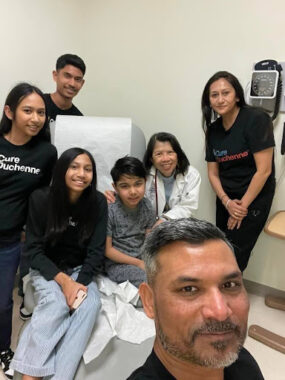
Rayyan Asif takes a photo with his family during a visit with Brenda Wong, MD, a pediatric neurologist who specializes in DMD, in February 2024. From top left are Saman Khan, Amaan Asif, Zara Asif, Rayyan Asif, Wong, Samin Khan, and Kamran Asif in the foreground. (Courtesy of CureDuchenne)
Since then, her life has been a “roller coaster,” with plenty of ups and downs.
“There are days when I look at my son and he seems healthy and has more strength, and I feel like, OK, we’ll be good. But then some days he suffers from falls and has less strength and more weakness … and I wonder how to prepare myself for the next level, and what will be the next stage,” Khan says.
While Rayyan’s condition is currently stable, he has a scooter and uses braces to help him walk, although he tires after about a block.
Early on, Khan looked into PT but found the therapists’ knowledge about DMD lacking, so Rayyan does stretching exercises at home. She did ultimately find suitable occupational therapy and aquatic PT.
“He loves the water. He’s like a fish in there,” she says. In addition to swimming, Rayyan enjoys gaming and drawing.
Because Rayyan, whom she homeschools, occasionally has a difficult time emotionally, Khan is looking into counseling for him.
“There are days he’s OK and days he does complain, and has meltdowns and cries, questioning why he has DMD. … We try to explain to him that everyone is different, but definitely his tears are not that easy to swallow,” Khan says.
She’s also considering counseling for herself, to help her cope with the stress of caregiving. But for now she finds emotional sustenance through Facebook support groups.
“I’m a big advocate for mental health,” says Khan, who attends CureDuchenne Cares workshops to meet other Duchenne families and learn about the latest treatments. “That’s very important. I try to make more DMD friends, and we provide great support to each other.”
Conner Curran, 13
Conner Curran, 13, lives in Ridgefield, Connecticut, with his parents, Chris and Jessica Curran, his twin brother, Kyle, and his 11-year-old brother, William.
The care Conner received when he was diagnosed was a “horrible experience” that provided no hope, Jessica Curran says. The family switched to an MDA Care Center, which offers specialized, comprehensive care for which she is grateful.

The Curran family, Chris, William, Kyle, Conner, and Jessica, poses for a photo at their home on Thanksgiving 2023. (Courtesy of the Muscular Dystrophy Association)
Conner is ambulatory, but has a scooter for long distances to preserve his muscle strength. Although he walks from class to class, he also uses the scooter in school hallways to avoid accidental bumps from fellow students.
Conner has aquatic PT twice weekly in addition to daily stretching exercises, and takes steroids and multiple heart medications. His parents installed a chairlift in the home so that he doesn’t have to use the stairs.
“He dresses himself, but he does need help with his shoes sometimes,” says Jessica Curran, who teaches first grade. “He’s very independent … sometimes he wakes up tired and I’ll assist him.”
Conner loves to cook, watch sports, and get together with his friends. He also sees a counselor “just to talk about everyday stuff,” his mother says.
Jessica Curran says Conner has never questioned why he has the disorder and, in that way, has “taught us a lot in life.”
His father, Chris Curran, adds, “I know for a fact he wishes he didn’t have Duchenne so he could play sports and do other things. He handles it well, but at times he does get upset.”
While Conner’s siblings are very supportive, there are challenges.
“It’s hard for them. Duchenne affects the whole family,” says Chris Curran. “They get it and they understand, because he does get a little more attention. So we’ll have special dates for them to make them feel like everyone is loved the same.”
When he was 7, with help from the MDA, Conner became the first patient in a clinical study of a gene therapy trial aimed at improving muscle cell function. Jessica Curran says the expert guidance provided by the MDA Gene Therapy Support Network was invaluable.
Conner did extremely well, but they knew the treatment wouldn’t be a cure. Conner went from struggling to climb stairs to running up them. The increased strength, then stabilization, lasted about four years, for which Conner’s parents are happy and grateful. After that period, Conner began to slowly decline.
“He felt different,” says Jessica Curran about her son’s experience during those four years. “He said, ‘Mom, I’m not watching the kids play anymore, I’m playing with them.’”
She remains optimistic. She said the family will learn more at length about the therapy’s effect and is hoping for extended benefits.
“We don’t know what it’s doing right now to benefit him, whether it’s protecting his heart,” she says. “We’ll find out the data as time goes.”
Darrel Nicklow Jr., 26
Darrel Nicklow Jr., 26, who was diagnosed with DMD at age 5, is a busy man.
He is a digital content creator and has been a graphic designer since 2016.
He started his own company, Limitless Designs, which he runs from his parents’ home in Arcadia, Florida, where he also lives. His mother is his full-time caregiver.
He posts lifestyle and sports videos on his YouTube channel, DNick Productions. And last year, he was the lead content creator for PTC Therapeutics’ Power Wheelchair World Cup video campaign.
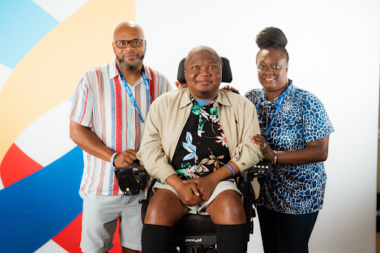
Darrel Nicklow Jr., flanked by his parents, Darrel Nicklow Sr. and Chaikia Davis, pose for a photo at CureDuchenne’s annual Futures Conference in May 2024. (Courtesy of CureDuchenne)
“One thing about me, I actually want to work and do things. I don’t want to sit and watch TV. I’m out in the community every day,” Nicklow says.
Nicklow also loves to watch sports and go to the movies and museums. He’s also active with CureDuchenne, an organization he calls “amazing.”
Nicklow became interested in design while a high school senior, after his first plan didn’t work out.
“I had wanted to be a chef originally, then I fell in love with graphic design,” says Nicklow, who has a master’s degree in curriculum and instruction. “I was getting weaker at the time and couldn’t cook anymore. … It’s easier as an artist. I’d rather do that than feel like I’m going to get burned.”
Nicklow has leg braces, and at 16, he began using a motorized wheelchair, the kind that supports him in a standing position. He also has a special table that helps his arms remain stable while he’s on his computer.
Due to congestive heart failure brought on by DMD, Nicklow had a heart transplant in 2011, from which he recovered well. He has PT twice weekly and regularly sees a counselor, which he says makes a difference.
“It lets me know that there’s always a bigger light at the end of the tunnel,” he says.
Muscular Dystrophy News Today is strictly a news and information website about the disease. It does not provide medical advice, diagnosis or treatment. This content is not intended to be a substitute for professional medical advice, diagnosis, or treatment. Always seek the advice of your physician or other qualified health provider with any questions you may have regarding a medical condition. Never disregard professional medical advice or delay in seeking it because of something you have read on this website.
Related articles

